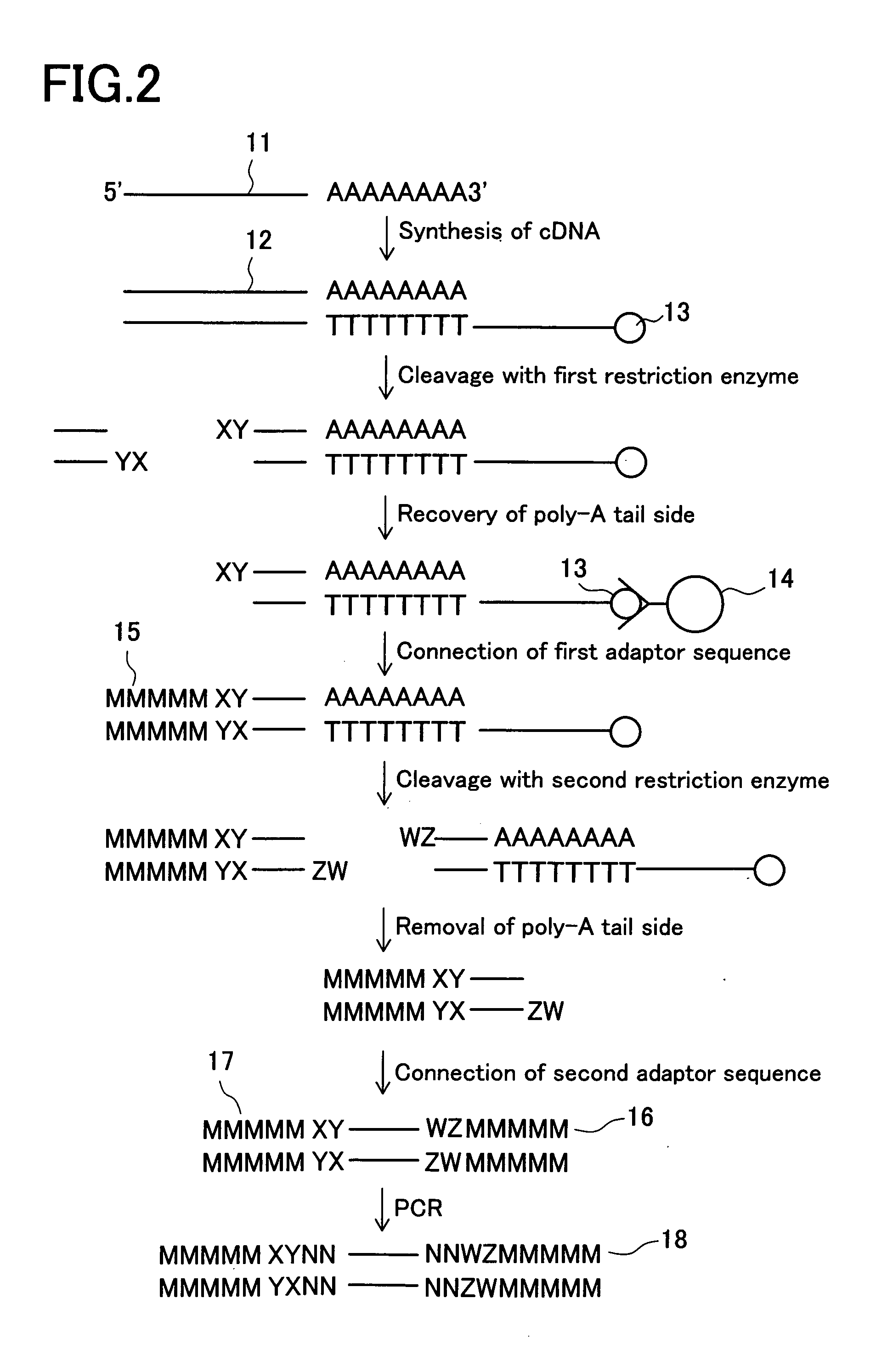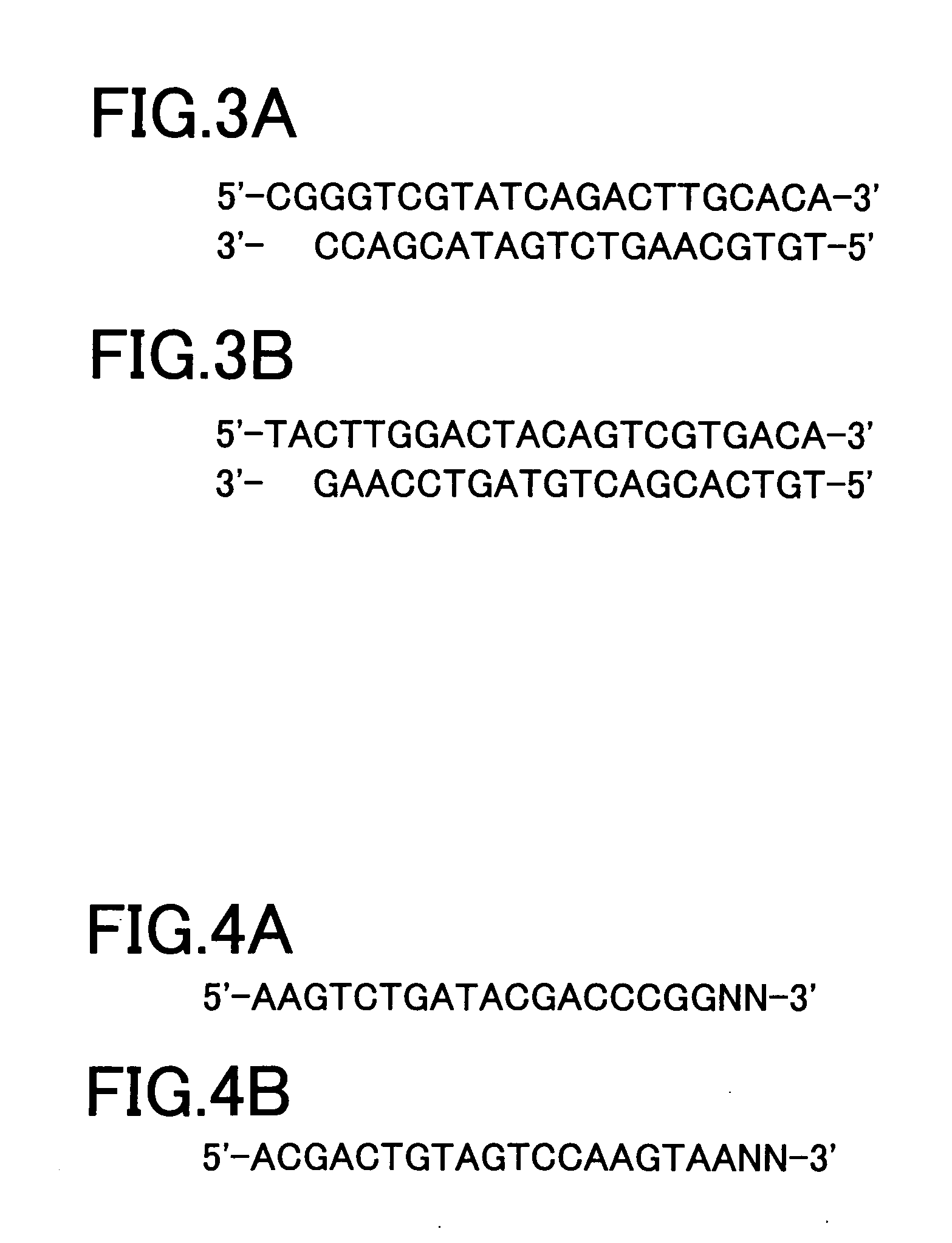Methods for DNA recovery
a dna fragment and recovery technology, applied in the field of recovering dna fragments, can solve the problems of inability to recover cdna fragments, and achieve the effect of efficient and specific amplification
- Summary
- Abstract
- Description
- Claims
- Application Information
AI Technical Summary
Benefits of technology
Problems solved by technology
Method used
Image
Examples
example 1
[0062] In the present example, at first, genes expressed in certain cells are grouped as described below. First of all, a group of cDNAs is synthesized from extracted mRNAs. Then, cDNAs of the obtained group are cleaved by two appropriate restriction enzymes, and both cleaved ends thereof are connected with adaptor sequences to prepare a group of cDNA fragments, each having a length enough to be recognized and having the adaptor sequences at both ends. Subsequently, the obtained group of cDNA fragments is divided into a plurality of groups by using a plurality of different primer sets.
[0063] Referring now to FIG. 1, the classification method will be described. From Group 1 consisting of the expressed mRNAs, Group 2 of cDNAs is synthesized by a method known in the art. Then, Group 2 is subjected to cleavage with two appropriate restriction enzymes to obtain Group 3 of cDNA fragments. Subsequently, Group 3 of cDNA fragments is further divided on the basis of the sequence for two base...
example 2
[0126] Next, a second example will be described. In the following, the description regarding the same procedures as those of the above-mentioned Example 1 will be omitted or simplified.
[0127] Even though a cDNA fragment of interest was recovered by the above method, some samples resulted in slightly lower recovery rate (see Table 1). This is because the amount of the cDNA fragment of interest itself is small. Accordingly, if only a gel portion where the cDNA fragment of interest is present could be cut out precisely, the contamination with other cDNA fragments could be reduced, leading to an improvement in the recovery rate of the cDNA fragment of interest. Thus, in order to improve the recovery rate of the cDNA fragment of interest, an experiment was carried out using the following method.
[0128] Procedures up to a first PCR step were carried out in the same manner as the above-mentioned Example 1.
[0129] Then, in an electrophoresis step, acrylamide gel electrophoresis was perform...
example 3
[0142] Next, a third example will be described. In the following, the description regarding the same procedures as those of the above-mentioned examples will be omitted or simplified.
[0143] Although the cDNA fragments derived from the known genes were recovered and analyzed in Example 1 and Example 2, a cDNA fragment derived from an unknown gene is recovered and analyzed in the present example. When the cDNA fragment derived from the unknown gene is analyzed, there are two possible methods for finding out whether the cDNA fragment which has been recovered is the target cDNA fragment or not.
[0144] That is, in one method, when a group of cDNA fragments is subjected to gel electrophoresis with a marker and the length of a cDNA fragment of interest is determined precisely based on an agreement between the length of the cDNA fragment and the length of the marker, and so on, whether the cDNA fragment which has been recovered and analyzed is the target cDNA fragment or not is to be deter...
PUM
| Property | Measurement | Unit |
|---|---|---|
| temperatures | aaaaa | aaaaa |
| gel electrophoresis | aaaaa | aaaaa |
| time | aaaaa | aaaaa |
Abstract
Description
Claims
Application Information
 Login to View More
Login to View More - R&D
- Intellectual Property
- Life Sciences
- Materials
- Tech Scout
- Unparalleled Data Quality
- Higher Quality Content
- 60% Fewer Hallucinations
Browse by: Latest US Patents, China's latest patents, Technical Efficacy Thesaurus, Application Domain, Technology Topic, Popular Technical Reports.
© 2025 PatSnap. All rights reserved.Legal|Privacy policy|Modern Slavery Act Transparency Statement|Sitemap|About US| Contact US: help@patsnap.com



